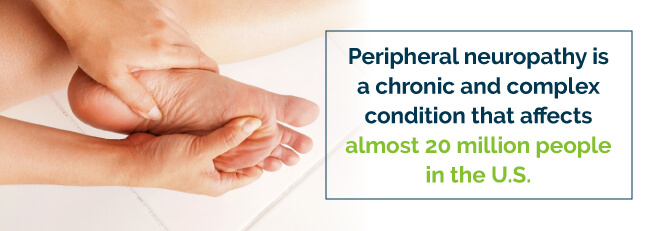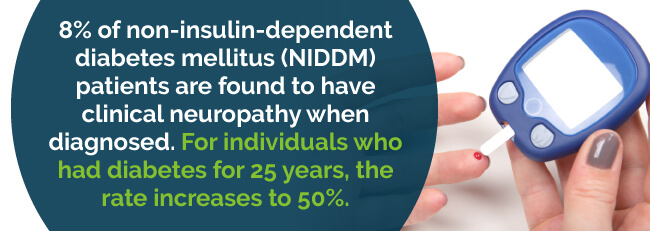
Peripheral neuropathy is a chronic and complex condition that affects almost 20 million people in the U.S.Telltale symptoms of the condition are numbness, weakness and pain — particularly in extremities like your feet and hands. Recently, people have begun turning to medical marijuana for peripheral neuropathy to relieve their pain associated with the condition.

Lately, cannabis is showing promise in providing relief to patients who aren’t finding relief from other types of treatment. This efficacy is mainly due to the relationship of the substance to your internal endocannabinoid system. Inhaling marijuana can thwart diabetic neuropathy pain while not impairing cognitive function significantly, according to a new study. And, the higher dose you use, the more relief you get for your pain.

Your peripheral nerves identify sensations of pain and contain cannabinoid receptors any form of marijuana consumption can impact. When CBD and THC enter your body, they activate your body’s CB1 and CB2 receptors to regulate your central nervous system and neurotransmitters, assisting in managing your levels of pain.
One study in 2010 showed inhaling a single 25 mg dose of 9.4 percent THC herbal marijuana three times a day, five days a week, helped reduce pain intensity, improve sleep and was tolerated well.
Another 2013 study showed when researchers compared medical weed with standard neuropathic pain medicine, the weed reduced pain effectively at small 1.29 percent doses and 3.53 percent medium doses.
Find A Doctor Find A Dispensary
Marijuana for peripheral neuropathy, despite low active cannabinoid concentrations, reduced chronic pain linked to peripheral neuropathy in participants of another study. It also eased their acute pain. The pain relief the medical cannabis provided during the study was equivalent to or even better than the pain relief other drugs like tricyclic antidepressants, anticonvulsants and other medications evaluated for peripheral neuropathy provided.
Chronic pain from neuropathy can lasts for weeks or even years, and is persistent. It’s usually caused by nerve damage and may leave patients feeling hopeless.
This pain may get so overwhelming it eventually causes depression in patients. Patients often turn to strong prescription medications like Oxycodone and Vicodin just for the smallest bit of relief possible to get through the day.
For many years, these strong chemical medications were the only options patients had to treat their chronic pain and often led to dependence. However, cannabis is now becoming more widespread, and both patients and researchers are finding it just may be an excellent alternative to these harsh, potentially addictive medications.
Cannabis and peripheral neuropathy treatment can help with peripheral neuropathy symptoms such as:
Researchers continue to look into the mechanism of how cannabis works in treating peripheral neuropathy symptoms. One theory is the natural endocannabinoid system of your body — also related to various functions like memory, pain, appetite and mood — runs parallel to the endorphin system in some respects, and the endorphin system plays an important and well-known role in pain management.
Certain marijuana and peripheral neuropathy strains could help you find relief from your pain and other peripheral neuropathy symptoms. Below are some strains recommended based on the chemical makeup of their terpene profiles, cannabinoids and CBD-to-THC ratios. Also, work with your medical marijuana doctor or budtender to learn about other cannabis strains that might be helpful for peripheral neuropathy.
Peripheral neuropathy patients can use a variety of methods to take cannabis.
No matter what strain and method you decide on for your marijuana and peripheral neuropathy therapy, you still require a recommendation from a licensed medical marijuana doctor. You also need a reputable place to get your medical cannabis.
New Mexico, Arkansas, North Dakota and Montana already approve peripheral neuropathy as a qualifying condition for medical cannabis. Many other states approve chronic pain. Here at MarijuanaDoctors.com, you can check your state and search for a medical marijuana dispensary or get in touch with a doctor easily all under one roof.
Find A Doctor Find A Dispensary
Peripheral neuropathy occurs when you have nerve damage. Not only does it cause numbness, pain and weakness in your feet and hands, but it also affects other parts of your body, as well.
Many people with peripheral neuropathy typically describe the pain they experience as burning, stabbing or tingling. Symptoms improve in many cases, particularly if a treatable condition, such as diabetes, causes it.
Your peripheral nervous system sends information from your spinal cord and brain to other areas of your body. A common cause of peripheral neuropathy is diabetes mellitus, but the condition can result from a variety of other causes like infections and traumatic injuries.
Peripheral neuropathy may be brought on by:
Certain medications, such as medications for cancer or HIV/AIDS, may also bring it on. When you have peripheral neuropathy and don’t know the cause, it’s referred to as “idiopathic.”
There’s little information on the natural history and incidence of neuropathy in individuals who aren’t dependent on insulin for diabetes mellitus. What we do know is 8 percent of non-insulin-dependent diabetes mellitus (NIDDM) patients are found to have clinical neuropathy when diagnosed. For individuals who had diabetes for 25 years, the rate increases to 50 percent.

The prevalence of NIDDM patients with polyneuropathy increases with time and may be more prominent in patients with hypoinsulinemia, which is a condition of having abnormally low levels of insulin in your blood.
Symptoms of peripheral neuropathy typically begin with prickling, numbness or tingling in the fingers or toes. It can spread up to your hands or feet and cause freezing, burning, shooting or throbbing pain, which often worsens at night.
You may feel either periodic or constant pain, but generally, you feel the pain on both sides of your body equally in both feet and hands. Some types of peripheral neuropathy develop suddenly. Others come on gradually over many years.
Peripheral neuropathy symptoms often include:
The symptoms you experience depend on which of your peripheral nerves have damage. You have three peripheral nerve types: sensory, motor and autonomic.
In some neuropathy cases, all three nerve types are affected together, while others only affect one or two. Most patients with this condition suffer from polyneuropathy, which is where damage occurs to many nerves simultaneously.
The nerve damage from this condition can have lasting effects that include the below physical and mental repercussions.

According to the Foundation for Peripheral Neuropathy:
Goals of treatment are to address the underlying condition causing your peripheral neuropathy to relieve your symptoms. If there’s no underlying condition detected in lab tests, your doctor may monitor you closely to see if you show improvement in your neuropathy.
Along with medications used to treat any underlying conditions you have associated with your peripheral neuropathy, other medications, including those below, can also relieve your symptoms.
Pain relievers: For mild symptoms, over-the-counter pain medicine, such as nonsteroidal anti-inflammatory drugs, can help. If your symptoms are more severe, your doctor may prescribe you prescription pain relievers like oxycodone or tramadol. However, these opioids can lead to addiction, so your doctor should only prescribe them when other medications can’t effectively relieve your pain.
Depending on the medication, you may have:
Anti-seizure medications: Your doctor may prescribe medications, like pregabalin or gabapentin, to treat the nerve pain you’re experiencing.
You may experience:
Topical treatments: Medications, such as capsaicin cream, may offer you modest improvements in peripheral neuropathy symptoms. You may have some skin irritation and burning in the area where you apply the cream. You may also apply lidocaine patches to your skin to relieve your pain.
You may experience:
Antidepressants: These medications include tricyclic antidepressants such as doxepin and amitriptyline, and physicians also prescribe them for pain relief.
Serotonin and norepinephrine reuptake inhibitors like Cymbalta can ease the diabetes-related pain of peripheral neuropathy.
You may experience:
If you have an inflammatory condition, your doctor may recommend treatments to temporarily suppress the activity of your immune system. Plasma exchange is the removal of your blood to remove antibodies and different proteins from it and then return it to your body. Immune globulin is where your body receives high levels of proteins acting like immunoglobulins, or antibodies.
With TENS, the doctor places electrodes on your skin to deliver gentle and varying frequencies of electric current. TENS is typically applied for a month, 30 minutes a day.
When you’re experiencing muscle weakness, this type of therapy can help improve your movements. In addition to physical therapy, you may also have to use a cane, foot or hand braces, wheelchair or walker, depending on your level of movement and mobility. Some patients try dry brushing to increase circulation and improve neuropathic pain through nerve stimulation.
Surgery may be necessary if you have nerve pressure causing your neuropathy, such as pressure from a tumor. You may have drainage, bleeding or swelling at the site of surgery.
To help you manage your peripheral neuropathy:
Medical cannabis for peripheral neuropathy is another option we’ll go over next.